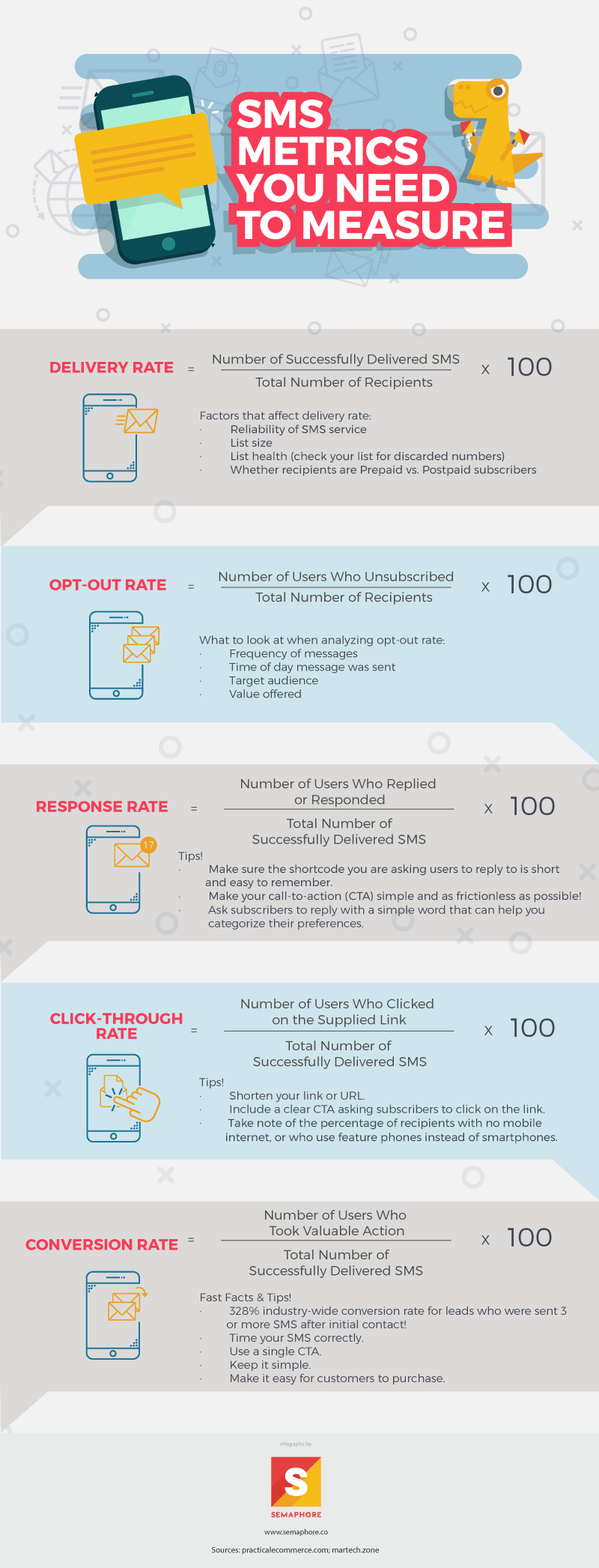Performance measurement and analysis are important in any business strategy. The same goes with SMS marketing campaigns. Metrics allow you to determine whether your campaign reached its goals and targets.
By analyzing the key metrics relevant to your SMS gateway and knowing the industry standards for every metric, you can determine which areas of your campaign need improvement. Furthermore, you can adjust your targets to be more realistic and attainable for your campaign.
Check out our infographic to learn the 5 key metrics you need to measure when launching an SMS blast. Included are tips and fast facts that can help you boost your SMS performance.

1. Delivery Rate
Your delivery rate pertains to the total number of messages successfully delivered out of the total number of recipients included in your SMS blast. It tells you how reliable your SMS marketing provider is. Cheaper SMS marketing platforms sometimes fail to send SMS messages successfully due to weaker infrastructure.
(Number of Successful Delivers / Total Number of Recipients)*100
It’s important to note that several factors are involved in the delivery of your SMS including the size and health of your contacts list, message frequency, and prepaid phone number composition. Cellular signal in specific areas of the country can also affect your delivery rate.
It’s easy for users to discard prepaid phone numbers and switch to a new one. This is especially common in the Philippines, where prepaid SIM cards are either given for free or sold for ₱10 to ₱50. Check your list health regularly to determine the active numbers from the inactive ones. Delete the inactive numbers from your contacts list to improve your delivery rate.
2. Opt-Out Rate
The opt-out rate shows the percentage of users who unsubscribed to your SMS marketing list after reading your text message. The average industry opt-out rate is usually below 5%. You don’t want to lose subscribers! A high opt-out rate tells you that you might need to take a second look at your campaign offering to improve retention rates.
(Number of Unsubscribes / Total Number of Recipients)*100
Some users don’t want to be bombarded with frequent messages, especially if they receive these messages during inopportune times. A high opt-out rate could also mean that you’re targeting the wrong audience, or your messages don’t provide value to your subscribers. Find a way to engage your users with compelling text messages.
Split testing your SMS campaign can help you isolate the areas for improvement, and decrease opt-out rate.
3. Response Rate
SMS has a 45% response rate while email only has a 6% response rate. This means that users respond to almost half of all text messages they receive on their mobile phones. Placing clear calls-to-action in your SMS message encourages subscribers to take the next step.
(Number of Users Who Responded / Number of Successful Deliveries)*100
If you’re reaping low response rates, the simplicity of your call-to-action may have something to do with it. Make sure to refrain from complicated requests. Provide clear instructions to avoid confusing your audience. Keep things easy and simple. You can even ask your subscribers to text back with a single word or code.
4. Click-Through Rate
The use of smartphones and mobile internet increases every year, enabling marketers to adopt multichannel marketing campaigns. If you include a website link in your SMS blast, you need to measure your click-through rate. According to recent surveys, the average click-through rate of URLs included in an SMS blast is at 36%.
(Number of Users Who Clicked / Number of Successful Deliveries)*100
If your campaign generates a low click-through rate, then take a second look at your target demographic. Do they use a cell phone or a smartphone? You may want to include this in your next SMS blast. Ask your subscribers if they own a cell phone or a smartphone. You can also try to determine whether your smartphone users have access to mobile internet, as this can greatly affect your click-through rate when using CTA links.
5. Conversion Rate
Conversion rate refers to the percentage of users who completed your goal by taking your desired action. This can pertain to when users sign up for a service, purchased a product, visited your store, clicked through to your website, or called your company.
(Number of Users Who Took Action / Number of Successful Deliveries)*100
Overall, the conversion rate tells you whether your SMS campaign is on the right track to generating leads and increasing your revenue. Industry standards show a 328% conversion rate for leads who are sent three or more text messages after their initial contact.
6. Unsubscribe Rate
SMS unsubscribe rate is the percentage of subscribers who opt-out of receiving SMS messages from your business. This is important because it indicates the level of engagement and satisfaction of your SMS subscribers. A high unsubscribe rate may indicate that your messaging is not resonating with your audience or that you are sending too many messages.
(Number of Subscribers who Opted-out / Total Subscribers)*100
To reduce SMS unsubscribe rates, businesses can take several steps such as ensuring that their messages are personalized, relevant, and valuable to the recipient, limiting the frequency of messages, and providing an easy opt-out option for subscribers.
Measuring the Right SMS Metrics
SMS is the fastest way to reach your target consumers or audience, as it is still the most popular messaging tool used by cellphone and smartphone users. Make sure that you’re tracking your progress by measuring the relevant SMS metrics.
Reach your bottom line faster with an SMS platform that delivers results. At Semaphore, we help businesses grow by providing an SMS service at low costs. Make sure that you partner up with a reliable SMS blasting service so that your SMS messages are sent to the right recipients instantly.
